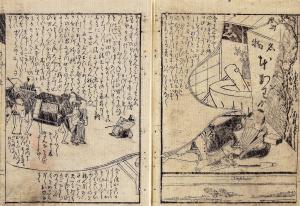Kinkin-sensei's Dream of Splendor (Kinkin Sensei Eiga no Yume)
Painted by Koikawa Harumachi 1775 (Anei 4) Kaga Collection hako 41-14
During the Annei (1772-1781) and Bunka (1804-1817) periods, kibyōshi (illustrated storybook with a yellow cover) for commoners became very popular. It is said that the first kibyōshi was "Kinkin sensei eiga no yume" by Koikawa Harumachi.
The author, Koikawa Harumachi (1744-1789) was very talented and known as a kyōgen (satirical) poet, kibyōshi (illustrated storybook with a yellow cover) writer and ukiyo-e (woodblock prints) artist. Born in a samurai family, he became a core member of Suruga Kojima somain as an officer of Takiwaki-Matsudaira family and he had access to information about the domain government.
He became a popular author with "Kinkin Sensei Eiga no Yume". In 1788 (Tenmei 8), he published "Ōmu Gaeshi Bunbu no Futamichi". Soon afterwards, the book became a subject of control for having criticized the Shogunate and Harumachi passed away some time after this.
The book was based on the scenario of "Kōryō Issui no Yume" of a noh song "Kantan". On a slit that was put on the inside of the cover of the second edition of the book, there was a picture of the main character Kinmura Kinbei. The picture shows him lying and dreaming of an awa-mochi (millet cake) shop on his way to moving to Edo.
The character is welcomed by a rich merchant as the future head, but he keeps spending money and plays around until he is kicked out – then, he wakes up and realizes that the peak of one's life passes while cooking awa-mochi. Waking from a dream, he decides to go back to his home town. With modern and intelligent description, the book is regarded as a historical work that heralded the beginning of the "kibyōshi" period.


